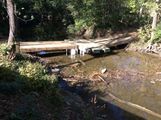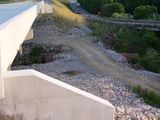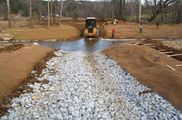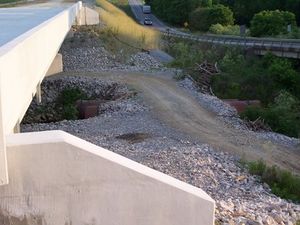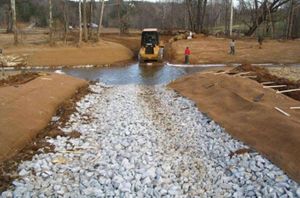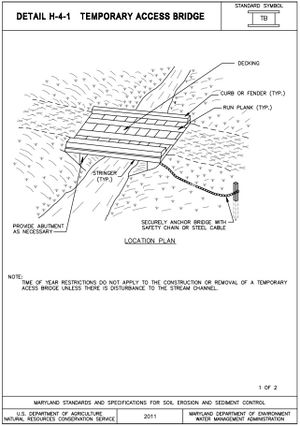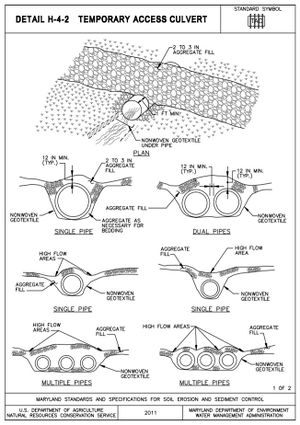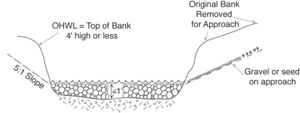
Difference between revisions of "Construction stormwater practices - temporary stream crossing"
m |
|||
| Line 116: | Line 116: | ||
If construction of the temporary stream crossing requires dewatering of the site, construct a '''bypass channel''' ([https://stormwater.pca.state.mn.us/index.php?title=Construction_stormwater_practices_-_diversion_and_working_in_the_dry Diversion and working in the dry]) before undertaking other work. Stabilize the bypass channel using [https://stormwater.pca.state.mn.us/index.php?title=Erosion_prevention_practices_-_Riprap riprap] or other suitable materials based on the anticipated velocity of flow. | If construction of the temporary stream crossing requires dewatering of the site, construct a '''bypass channel''' ([https://stormwater.pca.state.mn.us/index.php?title=Construction_stormwater_practices_-_diversion_and_working_in_the_dry Diversion and working in the dry]) before undertaking other work. Stabilize the bypass channel using [https://stormwater.pca.state.mn.us/index.php?title=Erosion_prevention_practices_-_Riprap riprap] or other suitable materials based on the anticipated velocity of flow. | ||
| − | The following general construction specifications are applicable for all temporary stream crossings | + | The following general construction specifications are applicable for all temporary stream crossings. |
*During installation of the temporary stream crossing, limit instream excavation to the minimum extent required to allow installation and removal of the crossing. | *During installation of the temporary stream crossing, limit instream excavation to the minimum extent required to allow installation and removal of the crossing. | ||
*The centerline of the crossing should align with the centerline of the roadway approaches on both sides for at least 50 feet from each stream bank. A shorter distance may be approved on a site-specific basis if physical constraints preclude the 50 foot minimum. | *The centerline of the crossing should align with the centerline of the roadway approaches on both sides for at least 50 feet from each stream bank. A shorter distance may be approved on a site-specific basis if physical constraints preclude the 50 foot minimum. | ||
| Line 126: | Line 126: | ||
[[File:Stream3.jpg|300px|thumb|left|alt=temp stream crossing schematic|<font size=3>Schematic drawing of a temporary bridge crossing. (Source: Maryland Department of the Environment, 2011). Click on image to enlarge.</font size>]] | [[File:Stream3.jpg|300px|thumb|left|alt=temp stream crossing schematic|<font size=3>Schematic drawing of a temporary bridge crossing. (Source: Maryland Department of the Environment, 2011). Click on image to enlarge.</font size>]] | ||
| − | The following construction recommendations and specifications apply to bridges as temporary stream crossings | + | The following construction recommendations and specifications apply to bridges as temporary stream crossings. |
| − | *If the channel | + | *If the channel width exceeds 8 feet (top of bank to top of bank), bridge support such as pier(s) or footing(s) may be necessary at the rate of one per each additional 8 feet width of channel. |
*Construct the temporary bridge at or above the bank elevation and place abutments parallel to and atop stable banks. | *Construct the temporary bridge at or above the bank elevation and place abutments parallel to and atop stable banks. | ||
*Select decking materials that are of sufficient strength to support the anticipated load. | *Select decking materials that are of sufficient strength to support the anticipated load. | ||
| Line 136: | Line 136: | ||
[[File:Stream4.jpg|300px|thumb|alt=temp stream crossing schematic|<font size=3>Schematic drawing of a temporary culvert crossing. (Source: Maryland Department of the Environment, 2011). Click on image to enlarge.</font size>]] | [[File:Stream4.jpg|300px|thumb|alt=temp stream crossing schematic|<font size=3>Schematic drawing of a temporary culvert crossing. (Source: Maryland Department of the Environment, 2011). Click on image to enlarge.</font size>]] | ||
| − | The following construction recommendations and specifications apply to culverts as temporary stream crossings | + | The following construction recommendations and specifications apply to culverts as temporary stream crossings. |
*Minimize disturbance (clearing, excavation, etc.) of the stream banks and stream bed. | *Minimize disturbance (clearing, excavation, etc.) of the stream banks and stream bed. | ||
| − | *Install a layer of geotextile fabric on the stream bed and stream banks prior to placement of the pipe(s) and aggregate. The geotextile should extend 6 to 12 inches beyond the ends of the culvert. | + | *Install a layer of '''geotextile fabric''' on the stream bed and stream banks prior to placement of the pipe(s) and aggregate. The geotextile should extend 6 to 12 inches beyond the ends of the culvert. |
*The culvert should be installed such that the invert is on the natural stream bed grade to minimize interference with fish passage. Lay culvert(s) directly on flattened channel bottom; do not excavate. | *The culvert should be installed such that the invert is on the natural stream bed grade to minimize interference with fish passage. Lay culvert(s) directly on flattened channel bottom; do not excavate. | ||
| − | *Backfill the culvert(s) with riprap and/ or 3-inch to 5-inch (i.e., #2) washed stone (do not use soil) to meet minimum cover requirements and create the road crossing. Backfill should be at least 1 foot higher | + | *Backfill the culvert(s) with riprap and/ or 3-inch to 5-inch (i.e., #2) '''washed stone''' (do not use soil) to meet minimum cover requirements and create the road crossing. Backfill should be at least 1 foot higher than the grade at either approach. |
*Cover the culvert(s) with a minimum of 12 inches of aggregate or one-half the pipe diameter, whichever is greater. Place top fill so that the stream overflow will occur in the center of the crossing, to prevent bypasses and bank erosion during higher flows. Extend rock driveway up the banks for at least 15 feet on both sides to prevent erosion and reduce saturated soil conditions where equipment will be driven. Use geotextile liner under the rock. | *Cover the culvert(s) with a minimum of 12 inches of aggregate or one-half the pipe diameter, whichever is greater. Place top fill so that the stream overflow will occur in the center of the crossing, to prevent bypasses and bank erosion during higher flows. Extend rock driveway up the banks for at least 15 feet on both sides to prevent erosion and reduce saturated soil conditions where equipment will be driven. Use geotextile liner under the rock. | ||
*If using multiple culverts, lay them side-by-side to accommodate stream flow. | *If using multiple culverts, lay them side-by-side to accommodate stream flow. | ||
| Line 147: | Line 147: | ||
[[File:Stream5.jpg|300px|thumb|alt=temp stream crossing schematic|<font size=3>Example low-water ford crossing (MN DNR). Click on image to enlarge.</font size>]] | [[File:Stream5.jpg|300px|thumb|alt=temp stream crossing schematic|<font size=3>Example low-water ford crossing (MN DNR). Click on image to enlarge.</font size>]] | ||
| − | The following construction recommendations and specifications apply to fords as temporary stream crossings | + | The following construction recommendations and specifications apply to fords as temporary stream crossings. |
*During construction, divert the stream using an approved temporary stream diversion. | *During construction, divert the stream using an approved temporary stream diversion. | ||
| − | *Install erosion and sediment control devices, including perimeter controls, before constructing fords and ensure they remain in place until any disturbed areas are stabilized. | + | *Install erosion and sediment control devices, including [https://stormwater.pca.state.mn.us/index.php?title=Sediment_control_practices_-_Perimeter_controls_for_disturbed_areas perimeter controls], before constructing fords and ensure they remain in place until any disturbed areas are stabilized. |
| − | *Approaches to the ford should be constructed out of stone pads, underlain by a geotextile fabric, and protected with a sufficient layer of aggregate (typically about 4 | + | *Approaches to the ford should be constructed out of stone pads, underlain by a geotextile fabric, and protected with a sufficient layer of '''aggregate''' (typically about 4 inch diameter). Do NOT place rock in the channel; only on approach ramps. |
| − | *Install a bedding layer consisting of coarse aggregate. Bedding material should be no deeper than 12 inches to minimize upstream ponding. | + | *Install a '''bedding layer''' consisting of coarse aggregate. Bedding material should be no deeper than 12 inches to minimize upstream ponding. |
*When constructing the ford, minimize blockage of stream flow and allow free flow over the ford to the extent practicable. | *When constructing the ford, minimize blockage of stream flow and allow free flow over the ford to the extent practicable. | ||
*Stabilize stream banks disturbed during ford installation. | *Stabilize stream banks disturbed during ford installation. | ||
Revision as of 17:20, 19 April 2019
This page is in review
A temporary steam crossing is a structure designed for short-term (typically less than one year) use that is installed across a watercourse to allow construction vehicles to safely cross without damaging the stream bed or channel. They may also be referred to as “temporary access” or “temporary access crossings.” The most common types of temporary stream crossings include bridges, culverts (or “pipe crossings”), and fords (or “drive-through crossings”).
- Images of three options for temporary stream crossings.
Contents
Purpose and function
The primary function of a temporary stream crossing is to prevent construction equipment from damaging the stream bed and banks, impeding stream flow, blocking fish migration, and tracking sediment and other pollutants into the stream.
Applicability
Because of the potential disturbance created by construction of a temporary stream crossing, they should be used only when they are completely necessary for construction purposes. Refer to Planning considerations for additional discussion. In general, temporary stream crossings are applicable when heavy equipment must be moved from one side of a watercourse to the other, or where lighter-duty construction vehicles require frequent, short-term access for crossing a stream channel.
Site applicability
Temporary stream crossings should be limited to locations with low erosion potential and should be constructed during dry periods to minimize stream disturbance and reduce costs. Select crossing sites away from trees, steep banks, channel bends, and deep pools. Stream channel conditions, including expected flow rates during the operation of the temporary crossing, should be thoroughly evaluated before choosing the appropriate type of stream crossing. For example, culverts and access fords may not be appropriate for large streams or during high flow conditions, as they may constrict flow and create potential safety hazards. Temporary bridges may be more suitable for these conditions and are also less likely to impede fish and aquatic life passage.
Although bridges are generally the most expensive to design and construct, they are often the preferred method for temporary stream crossings because they provide the least disturbance of the stream bed and constriction of stream flow. Culverts are less expensive than bridges, relatively easy to construct, and able to support heavy equipment loads. Fords are typically the least expensive to construct but are generally not appropriate for construction during rainy periods or on high-flow perennial streams. The table below provides additional information on the applicability of each temporary crossing and limitations of use.
Typical temporary stream crossing methods and their applicability.
Link to this table
| Stream crossing type | Applicability | Limitations |
|---|---|---|
| Temporary bridge |
|
Use in large channels may require pier(s) or other supports, which increase disturbance to stream (see Construction recommendations and specifications) |
| Temporary culvert (pipe) |
|
|
| Temporary ford (drive-through) |
|
|
Permit applicability
Temporary stream crossings require coordination with regulatory agencies, and may require local, state, or federal permits. A permit is required for placement of fill in a waterway under Section 404 of the Clean Water Act. The local U.S. Army Corps of Engineers (USACE) office should be contacted concerning the requirements for obtaining a 404 permit. In addition, a permit from the U.S. Fish and Wildlife Service (USFWS) may be needed if endangered species are known to be present in the work area.
Section 23.11 of the MPCA Construction Stormwater General Permit notes that when a water crossing is necessary in order to complete a construction project, disturbance of the required undisturbed buffer zone may be allowed if fully documented in the SWPPP. Specifically, Section 23.11 states: “Permittees must include an undisturbed buffer zone of not less than 100 linear feet from a special water (not including tributaries) and must maintain this buffer zone at all times, both during construction and as a permanent feature post construction, except where a water crossing or other encroachment is necessary to complete the project. Permittees must fully document the circumstance and reasons the buffer encroachment is necessary in the SWPPP and include restoration activities.”
A DNR Public Waters Work Permit may be required if the waterway is a public water, depending on the impact of the stream crossing. The following guidance is provided by the MN DNR:
To construct a bridge or culvert, or to fill or excavate the bed of a public watercourse having a total drainage area, at its mouth, of less than 5 square miles (3,200 Acres), a DNR Public Waters Work Permit is not required, provided
- county zoning officials and local Soil and Water Conservation District are given at least 7 days prior notice to determine that the project will not result in downstream erosion or sedimentation,
- the project will not divert water to a different watershed,
- the project will not impound water by damming the watercourse, and
- the watercourse is not an officially designated trout stream.
For low water ford crossings (on streams only), a DNR Public Waters Work Permit is not required when
- the crossing conforms to the shape of the natural stream channel,
- the original stream bank is no higher than 4 feet,
- the normal summer flow does not exceed 2 feet in depth,
- the normal summer flow is not restricted or reduced,
- no special site preparation is necessary,
- the crossing is constructed only of gravel, natural rock, concrete, steel matting or other durable, inorganic material not more than 1 foot thick,
- the finished graded slope is no steeper than 5:1 (horizontal to vertical),
- the graded banks must be seeded or mulched to prevent erosion and sedimentation, and
- the site is not an officially designated trout stream; wild, scenic or recreational river or officially designated canoe and boating route.
For temporary bridges (on streams only), a DNR Public Waters Work Permit is not required when
- the stream bank can support bridge without pilings, foundations, culverts, excavation, or other special site preparations,
- nothing is placed in the bed of the stream,
- the bridge is capable of removal for maintenance and flood damage prevention,
- the bridge is firmly anchored at one end and can swing away during flooding,
- a minimum 3 feet of clearance between the lowest portion of the bridge and normal summer stream flow is maintained, and
- the bridge construction is consistent with floodplain, shoreland, and wild and scenic river ordinances.
Effectiveness
As a standalone practice, temporary stream crossings are not intended to provide significant water quantity or water quality benefits. In fact, when they are not properly planned, constructed, maintained, and removed, temporary stream crossings can be a direct source of water pollution.
As noted above, temporary stream crossings provide a means for construction vehicles to cross streams without moving sediment into them, damaging the stream bed or channel, or creating flooding or safety hazards. To protect water quality, stream crossings should be located in areas where erosion potential is low, and a natural buffer should be preserved along the stream on both sides of the crossing. Additional recommended measures to protect water quality are discussed in Planning considerations.
If the appropriate considerations and protective measures are implemented, temporary stream crossings can serve as a stream protection measure by effectively reducing soil erosion and transport of sediment into streams.
Expected performance benefits for temporary stream crossings.
Link to this table
| Water quantity | |
|---|---|
| Flow attenuation | Little or no design benefit |
| Runoff volume reduction | Little or no design benefit |
| Water quality | |
| Pollution prevention | |
| Soil erosion | Primary design benefit |
| Sediment control | Little or no design benefit |
| Nutrient loading | Little or no design benefit |
| Pollutant removal | |
| Total suspended solids | Little or no design benefit |
| Total phosphorus | Little or no design benefit |
| Heavy metals | Little or no design benefit |
| Floatables | Little or no design benefit |
| Oil and grease | Little or no design benefit |
Planning considerations
With careful planning, the need for temporary stream crossings may be minimized or avoided altogether. If stream crossings cannot be avoided, the following should be considered when planning for the use of temporary stream crossings.
- Plan for stream crossings to be in service for the shortest practical amount of time and removed as soon as their function is completed.
- Place crossings strategically to reduce the number of crossings needed during construction.
- To the extent possible, minimize the number of trips back and forth across stream by completing construction activities on one side of the stream and then moving to the other side.
- Maintain a natural buffer zone along the stream.
- When planning for temporary stream crossings, consider that bridges pose the least potential for creating barriers to aquatic migration.
Design
Temporary crossings require coordination with regulatory agencies including USACE (Army Corps) for a permit. If in-channel disturbance is required to build the temporary crossing, temporary stream channel diversions should be used to minimize soil loss and erosion and be removed upon completion of the crossing. The following general design criteria apply for all temporary stream crossings:
- Select stream crossing sites along relatively straight channel reaches and away from deep instream pools and trees if possible. For piped and ford crossings, look for places where bank slopes are low and long. For fords, broad and rocky riffle areas are preferred, if available.
- Design the temporary stream crossing to be as perpendicular to the stream flow as possible. Under certain site conditions, the crossing angle may by up to 15 degrees from perpendicular.
- Do not use earth/soil material for construction within the stream channel. Any material placed in flowing water must not cause siltation (e.g., use clean rock and gravel).
- If the temporary crossing will be used for 2 weeks or less, design the crossing to convey the stream’s base flow.
- For temporary crossings to be used for longer durations, design the crossing with sufficient capacity to convey the 2-year, 24-hour flow without overtopping.
- Design the crossing such that the design flow velocity at the outlet is non-erosive for the receiving stream channel and install outlet protection.
- Design the temporary crossing to have a single traffic lane with a width between 12 feet and 20 feet.
- Temporary crossings should not significantly impede stream flow; therefore, do not design a crossing method that results in a significant water level difference between the upstream and downstream ends of the crossing.
Specific design considerations for each type of temporary stream crossing are provided below.
Bridges
The following design recommendations apply to bridges as temporary stream crossings.
- Temporary bridge crossings are typically constructed of wood, metal, or other approved materials; common materials include logs, sawn timber, prestressed concrete beams, or metal beams.
- Bridge deck materials should be capable of holding the maximum anticipated weight.
- Bridge crossings should be designed to minimize disturbance to the stream banks.
Culverts
The following design recommendations apply for culverts as temporary stream crossings.
- Design culverts with a minimum capacity to convey a 1-year flow or the stream’s base flow for projects shorter than two weeks and for the 2-year flows for all other projects. Multiple culverts or elliptical culverts may be used to achieve these flow capacities while providing minimum cover requirements.
- All culverts must be capable of supporting their cross-section area under the maximum expected loads of the project.
- Culvert diameters should be as wide as will fit into the existing stream channel without major excavation; the minimum culvert diameter used for a culvert crossing should be 12 inches; 18 or more inches is preferred.
- For channel widths greater than 3 feet, more than one culvert may be installed such that the cross-sectional area of the pipes exceeds 60 percent of the cross-sectional area of the existing stream.
- The culvert slope should mirror the slope of the existing stream.
- Culvert length should not exceed 40 feet
- Culverts should be designed to minimize the erosive power at their outlets so as to not damage the stream channel at the discharge point. Outlet protection can be installed to minimize this damage.
Fords
The following design recommendations apply for fords as temporary stream crossings.
- Approach roads should be no steeper than 5:1.
- Convey overland flow away from the temporary access ford approaches using diversions like a shallow swale, ensuring that discharge from the swale is non-erosive. Outlet protection or level spreaders can be used as necessary.
Construction recommendations and specifications
When temporary stream crossings cannot be avoided, complete construction activities in an expedient manner and stabilize the area immediately to limit the period of time during which the crossing is needed. Ensure that all necessary materials and equipment are on site before beginning work to minimize delays.
If construction of the temporary stream crossing requires dewatering of the site, construct a bypass channel (Diversion and working in the dry) before undertaking other work. Stabilize the bypass channel using riprap or other suitable materials based on the anticipated velocity of flow.
The following general construction specifications are applicable for all temporary stream crossings.
- During installation of the temporary stream crossing, limit instream excavation to the minimum extent required to allow installation and removal of the crossing.
- The centerline of the crossing should align with the centerline of the roadway approaches on both sides for at least 50 feet from each stream bank. A shorter distance may be approved on a site-specific basis if physical constraints preclude the 50 foot minimum.
- Any fill material associated with the roadway approach may not exceed a height of 2 feet above the existing floodplain elevation.
- Construct a swale across the roadway on both sides of the stream crossing to divert water and prevent roadway runoff from directly entering the stream. The swale should extend a maximum distance of 50 feet on either side (measured from the top of the stream banks).
- After constructing stream crossings, stabilize all areas disturbed during installation using riprap, vegetation, or other appropriate measures.
Bridges
The following construction recommendations and specifications apply to bridges as temporary stream crossings.
- If the channel width exceeds 8 feet (top of bank to top of bank), bridge support such as pier(s) or footing(s) may be necessary at the rate of one per each additional 8 feet width of channel.
- Construct the temporary bridge at or above the bank elevation and place abutments parallel to and atop stable banks.
- Select decking materials that are of sufficient strength to support the anticipated load.
- Ensure bridge crossing components are butted tightly and fastened securely to prevent soil tracked onto the bridge from falling into the stream.
- Securely anchor the bridge at one end using steel chain or cable. Anchors may include large trees, boulders, or driven steel anchors.
Culverts
The following construction recommendations and specifications apply to culverts as temporary stream crossings.
- Minimize disturbance (clearing, excavation, etc.) of the stream banks and stream bed.
- Install a layer of geotextile fabric on the stream bed and stream banks prior to placement of the pipe(s) and aggregate. The geotextile should extend 6 to 12 inches beyond the ends of the culvert.
- The culvert should be installed such that the invert is on the natural stream bed grade to minimize interference with fish passage. Lay culvert(s) directly on flattened channel bottom; do not excavate.
- Backfill the culvert(s) with riprap and/ or 3-inch to 5-inch (i.e., #2) washed stone (do not use soil) to meet minimum cover requirements and create the road crossing. Backfill should be at least 1 foot higher than the grade at either approach.
- Cover the culvert(s) with a minimum of 12 inches of aggregate or one-half the pipe diameter, whichever is greater. Place top fill so that the stream overflow will occur in the center of the crossing, to prevent bypasses and bank erosion during higher flows. Extend rock driveway up the banks for at least 15 feet on both sides to prevent erosion and reduce saturated soil conditions where equipment will be driven. Use geotextile liner under the rock.
- If using multiple culverts, lay them side-by-side to accommodate stream flow.
Fords
The following construction recommendations and specifications apply to fords as temporary stream crossings.
- During construction, divert the stream using an approved temporary stream diversion.
- Install erosion and sediment control devices, including perimeter controls, before constructing fords and ensure they remain in place until any disturbed areas are stabilized.
- Approaches to the ford should be constructed out of stone pads, underlain by a geotextile fabric, and protected with a sufficient layer of aggregate (typically about 4 inch diameter). Do NOT place rock in the channel; only on approach ramps.
- Install a bedding layer consisting of coarse aggregate. Bedding material should be no deeper than 12 inches to minimize upstream ponding.
- When constructing the ford, minimize blockage of stream flow and allow free flow over the ford to the extent practicable.
- Stabilize stream banks disturbed during ford installation.
MnDOT Specification 1717.1 Part B discusses the precautions that are required in order to prevent pollution of ground and surface waters when contractors must use stream crossings. Part B states: “The Contractor shall avoid the crossing of streams and rivers unless approved by the regulatory authority. The Contractor shall minimize water pollution from haul roads, work platforms, temporary earth fills, and other temporary staging areas used for construction. The Contractor shall restore all temporary crossings to pre-existing conditions or as shown in plan.”
Inspection and maintenance
In general, bridge crossings require less maintenance than culvert crossings, and ford crossings typically require the most intensive maintenance. The following general inspection and maintenance recommendations apply to all temporary stream crossings.
- At least weekly and after runoff-producing rainfall:
- Verify that the structure, stream bed, and stream banks are not damaged and that sediment is not entering the stream.
- Remove and dispose of accumulated sediment and debris.
- Replace aggregate that has washed away from culvert ends.
- Inspect temporary stream crossings after runoff-producing rains to check for blockage in channel, erosion of abutments, channel scour, riprap displacement, or piping in the soil.
- Inspect temporary crossing structure(s) for weakening, such as cracks and undermining of foundations and abutments.
- Make all repairs immediately to prevent further damage to the installation.
During construction of fords, the stream diversion method should be inspected daily for leakage and any repairs made immediately. Inspect perimeter control barriers periodically and repair as necessary. Removal of temporary stream crossings After a temporary stream crossing is no longer needed, it should be removed in the following general sequence:
- Inspect the site to confirm the practice is no longer needed.
- Remove temporary crossing as soon as it is no longer needed (within 14 calendar days).
- Remove sediment buildup in the area of the temporary crossing.
- Remove the temporary crossing.
- Restore the stream channel to its original cross-section.
- Stabilize and revegetate any areas disturbed by removal of the temporary crossing.
Removal of fords requires an approved temporary stream diversion method and dewatering of the construction area prior to removal of the ford. Stabilize any disturbed areas prior to removal of the stream diversion.
Costs
Costs for construction of temporary stream crossings are highly project-specific and may vary widely depending on the type of structure, the intended purpose, and the nature of the water course to be crossed.
Reference materials
Except where more stringent requirements are presented in this guidance, BMPs shall comply with MnDOT and other state requirements. Primary design references include the following.
- 2018 Minnesota NPDES/SDS Construction Stormwater General Permit
- 2018 MnDOT Standard Specifications for Construction
- Minnesota Department of Natural Resources: Temporary Bridges and Low-Water Ford Crossings (2008)
- MnDOT Erosion Control Handbook II
The following is a list of additional resources that are not specific to Minnesota:
- Contractor’s Handbook for Erosion, Sediment, and Stormwater Management on Capital Project Construction Sites (Lexington-Fayette Urban County Government) (2018)
- District of Columbia Erosion and Sediment Control Manual (Chapter 8.2)
- 2011 Maryland Standards and Specifications for Soil Erosion and Sediment Control (Chapter H-4)
- New York State Standards and Specifications for Erosion and Sediment Control (2016)
- Tennessee Erosion & Sediment Control Handbook (Fourth Edition, 2012) (Chapter 7.43)
